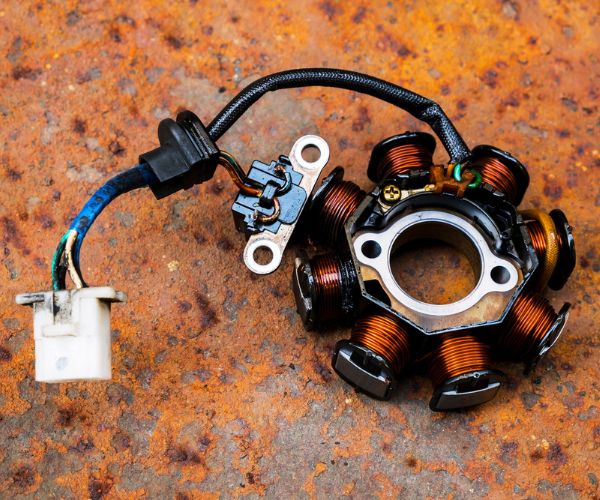Many people shy away from tackling electrical problems on their motorcycles as they don’t know where to start. A bad stator will show some distinct symptoms to help identify the fault.
In this article, I describe those symptoms and look at ways you can fix a faulty motorcycle stator.
What is a stator, and why should you care?
Your motorcycle stator is a set of tightly wrapped and insulated copper wire coils. The stator sits inside a rotor, which holds a collection of magnets. As the rotor spins around the stator, it generates electricity.

The motorcycle stator is an essential part of your bike’s electrical system. Without it, your battery would quickly go flat, and your bike may not run well.
The battery provides power to the starter motor, which turns the engine over. This, in turn, allows the stator to provide the high power required by the spark plugs.
Without the stator, your bike’s battery doesn’t have enough power to start and run the engine for very long.
Causes Of a Bad Stator
Time

Everything on your motorcycle degrades over time, and the stator is no exception. Your bike’s stator is well-protected, encased inside the rotor, and shielded from external elements. However, your motorcycle is repeatedly exposed to heat, cold, and vibration.
Your bike’s stator will give you years, if not decades, of reliable service, but time will eventually get to it.
Heat
The fastest way to damage your stator is to overload it. When manufacturers design their motorcycle electrical systems, they provide a power generation system to run the engine and ancillary components such as the lights.
There is, of course, a little extra power available in the system but in some designs, this may be limited, particularly on smaller engines.
Many bikers want to add extra equipment to their bikes. Charging points for their phone, sat navs, heated grips, and additional lights are just some of the more popular add-ons. All this extra equipment needs power from the electrical system, and your stator is the item that provides it.
Imagine riding in the winter. Your headlights are on; you’re using the heated grips. Maybe you have a heated jacket plugged into the charging socket and your phone. This is extra power that your stator wasn’t designed for.
Overloading your stator causes excessive heat in the coils, which can burn the copper cables and damage your rectifier.
Symptoms Of a Bad Stator
The symptoms of a bad stator can easily be confused with other potential problems. The main symptom is difficulty starting and poor running, but this could be your spark plugs, the ignition coils, ignition leads, bad fuel, and all manner of other causes. The stator is often overlooked.
One possible indicator of a stator fault is the effect of temperature. If the difficulty of starting your bike varies with engine temperature, you could have a stator problem.
Another helpful pointer is rough running at low revs or high revs only. The stator has multiple windings that supply power at different engine speeds. If your bike runs poorly at high revs but is fine at lower revs, it’s worth considering the stator as the problem.
Intermittent poor running is another pointer toward the stator failing. Again, this could vary depending on the temperature of the engine.
Also read about reasons a motorcycle dies when given throttle.
How To Test a Stator
There are two methods of testing, static and dynamic.
Static testing
To static test your stator, you measure the resistance in the coils with the engine switched off.
Using a multimeter, test the resistance between each of the stator phases. It should be an open circuit. Next, test between a phase and ground. Again, it should be an open circuit.
If any of the tests show a short circuit or low resistance, your stator has a problem that you’ll need to investigate.
Dynamic testing
Dynamic testing is a little more complicated. First, you need to be able to start the engine, so if that isn’t possible, your only option is static testing. Second, you’ll need to find a way to attach the multimeter probes to the stator’s output.
Assuming you can do the dynamic test, you are looking for a voltage output between 20 and 50 volts. Check your bike’s manual for the correct figures. When you rev your bike’s engine, the voltage should increase. If your stator does not give these readings, there is a problem.
Can You Repair a Stator?
It is possible to repair a stator, and some companies offer this service. You could also attempt to do it yourself, but this is quite a technical job.
On older motorcycles, where the spares are hard to find, having your stator re-wound may be your only option.
If spares are available, buying a new stator may be more cost-effective. You should get quotes for both options and decide from there.
Finally
A faulty stator is rare, except on older bikes, as the component is usually very reliable. However, when it does start to fail, it can be challenging to diagnose, and many home mechanics may not even think to test the stator.
If your bike’s engine is running poorly or not at all, and you’ve tried everything else, take a look at the stator.